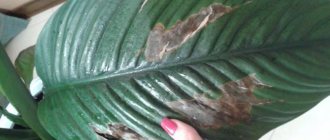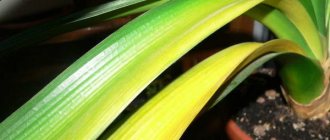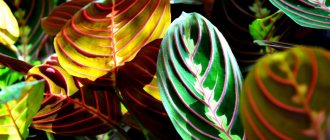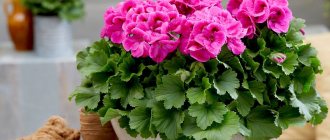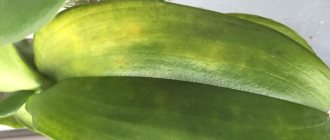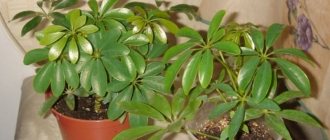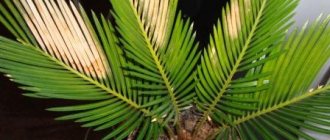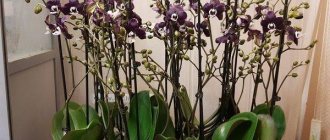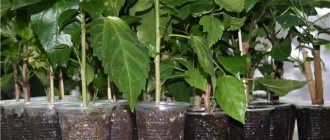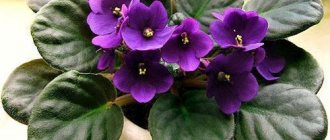How to care for Dieffenbachia at home and what to do if the leaves of a flower turn yellow are a pressing question among lovers of this crop.
Dieffenbachia is a herbaceous, showy perennial plant valued for its decorative large leaves. The homeland of this plant is North and South America. Belonging to the aroid family, Dieffenbachia is an evergreen shrub that grows in the American tropics.
We will talk further about how to care for Dieffenbachia at home if the leaves turn yellow and for what reason this happens.
Diseases and pests of Dieffenbachia
When caring for a plant, a gardener may encounter the following problems:
- The lower leaves of Dieffenbachia turn yellow - this is a sign of excess moisture in the soil and insufficient drainage.
- The lower leaves fall off - evidence of insufficient soil moisture or too low air temperature.
- Dieffenbachia leaves turn yellow and curl - this indicates that the plant is cold and suffers from a draft.
- The stem rots - this means that excessive watering is carried out in the cold.
- Brown edges of dieffenbachia leaves mean the water used to water the plant is too hard.
- The leaves at the top are small - the plant does not have enough sunlight, it needs to be moved to another place.
- Dieffenbachia leaves are wilting - this is another sign of excessive humidity combined with low temperature.
- Weeping spots on leaves indicate many problems, including late blight, anthracnose or fusairum.
- Yellow spots on Dieffenbachia leaves are a sign of bacterial spot.
- The leaves look burnt and acquire a brown tint - a signal that the owner is adding too much fertilizer to the soil.
In addition to diseases, pests can annoy the plant:
- aphid;
- scale insect;
- false scale insect;
- red spider mite;
- thrips.
Yellowing of leaves occurs for a number of reasons:
- insufficient lighting;
- excessive watering;
- burns from direct sunlight;
- high water hardness;
- The leaves dry out due to insufficient air humidity: when the humidity drops below 60%, it is dangerous for the plant, and it immediately becomes vulnerable to a dangerous pest - spider mites.
- Drafts and cold can also cause the leaves of the plant to dry out.
Mealybug
Mealybug on Dieffenbachia photo
Inspect the leaves of the plant regularly to detect pests in time. Dieffenbachia can be attacked by spider mites, scale insects, thrips, and aphids. If lesions are identified, repeated treatment with insecticides will be required: do not rely on a soap solution, it will not help.
How to treat Dieffenbachia from pests photo
There is no need to worry that such confinement will have a negative impact on the condition of the plant: a two-day “sauna” will only benefit Dieffenbachia.
Thrips on Dieffenbachia photo
The leaves lose their attractiveness and become covered with darkening, drying spots. These are thrips that are not so easy to get rid of. Multiple treatments with insecticide are needed: spray the plant and cover it tightly with a bag on top. Repeat treatments every two days 6-7 times. Then repeat the course of treatment after 10 days, since after this time new thrips will hatch from the last remaining larvae.
Spider mite
Spider mite on Dieffenbachia photo
The pest is practically invisible and can be guessed by the drying leaves and barely noticeable cobwebs on the bottom of the leaves. To get rid of spider mites, multiple treatments with an insecticide will be required; the plant is covered with a bag for 1-2 days. Treatments are repeated every 5-7 days, 3-4 times. This will require wet treatment of the window, window sill and the entire room.
Causes of yellowing of Dieffenbachia leaves
Dieffenbachia quickly reacts to changes in conditions by deteriorating its appearance. Its leaves often turn yellow, and sometimes even experienced gardeners cannot confidently name the reason for this.
Indeed, yellowing of leaves is caused by many factors: very bright lighting, excessive watering, changes in temperature and humidity, attack by pests and some others.
In the article you will learn what to do if the leaves of Dieffenbachia turn yellow, and you will also see the reasons why this happens.
Direct sunlight
When direct rays of the sun hit the leaves of Dieffenbachia, yellow-brown burns are formed, which lead to yellowing and drying of the entire leaf.
It should be remembered that Dieffenbachia should not be kept in the sun, but in partial shade..
In summer, the plant should be placed on a south-eastern window, where the sun's rays will hit it only in the morning.
Here the lighting will be sufficient for good growth, but without direct sun. If this is not possible and Dieffenbachia grows on a south-facing window, it must be shaded to avoid burns.
In winter, the flower requires fairly intense lighting. It is better to move it to the most illuminated windowsill. Winter sun rays will not harm the flower; you should not be afraid of direct sun during the cold season.
Strong hydration
Excessive moisture leads to fungal diseases of the plant. Excessive soil moisture easily leads to various fungal diseases.
When the roots rot, the leaves of the plant first fall down and then begin to turn yellow. Moreover, the plates throughout the plant turn yellow.
In case of rotting, Dieffenbachia needs an emergency transplant and reduced watering , and sometimes this does not help. We have to cut off and root the surviving tops.
To protect the plant from rotting, it is necessary to strictly adhere to its watering regime. You can’t overwater the flower, but you shouldn’t overdry the earthen ball either, as this can cause the death of the plant. Keeping the soil moist but not wet is quite simple. Watering is carried out only after the top layer of soil in the pot has dried to a depth of 2-3 cm.
Sometimes plants turn yellow as a result of root rot and with the correct watering regime. This happens when the soil composition is incorrectly selected. The soil for Dieffenbachia should be light. In heavy soils, water stagnation and root rot are possible.
Low air humidity
With insufficient watering and low humidity, Dieffenbachia leaves begin to turn yellow from below. First the tips turn yellow, then the entire leaf blade. Such plates dry out and fall off over time. This is often accompanied by loss of color and lightening of the upper leaves.
Often in a city apartment it is difficult to create the necessary air humidity for Dieffenbachia . In summer, the room is quite hot and dry; in winter, during the heating season, the air is dried out greatly by heating radiators. Therefore, for many inexperienced gardeners, Dieffenbachia is a long bare trunk with several leaves at the top.
For a plant to maintain its beauty, regular watering and spraying is not enough. It is useful to place it in a tray with a damp substrate: expanded clay, sand or moss. The substrate will humidify the air near the plant and also help preserve its green mass.
Reduced temperature and draft
Dieffenbachia is a heat-loving tropical plant. At low temperatures, Dieffenbachia can drop all its leaves (especially if the temperature drops sharply).
The leaves turn yellow very quickly throughout the plant and fall off, except for the very top ones.
The reaction of Dieffenbachia to a draft is drying out and yellowing of the tips of the leaves. If such symptoms occur, you need to move the plant away from opening windows, otherwise it may turn completely yellow and then lose all its foliage.
Dieffenbachia can also react when kept in an air-conditioned room. If you are near an air conditioner under a stream of cold air, it will certainly shed its leaves and lose its beautiful appearance.
You cannot keep this plant not only under air conditioning, but even away from it, because it does not tolerate temperature changes in such a room very well.
Closeness
In very small pots the plant becomes so cramped that it can no longer fully develop. At the same time, its growth slows down, it does not produce new shoots, its leaves begin to turn yellow, starting from the bottom. Regular replanting into new soil helps maintain the decorative appearance of Dieffenbachia .
The plant has a fairly powerful root system that grows quickly in the first years of life. Therefore, young plants must be replanted annually into new soil and a more spacious pot.
With regular replanting, the flower retains most of its leaves, losing only the lowest ones.
If you skip the transplant, this will immediately affect the appearance of the young plant, the leaves of which will begin to turn yellow and die.
Mature plants over 5 years old can not be replanted so often, since their root system grows much more slowly and fills the pot only every 2-3 years. But if the leaves of Dieffenbachia begin to turn yellow and fall off, it is necessary to replant it, as it may lose leaf mass, which is very difficult to restore.
Pest infestation
When attacked by spider mites, yellow spots first appear on the leaves of the plant, which then cover the entire leaf blade.
This pest is easy to detect on the underside of leaves, which can be completely covered with a thin web. Typically, treatment with special chemicals allows you to quickly destroy the pest.
Already yellowed plates cannot be restored . Over time, they dry out and fall off. But eliminating mistakes in plant care will lead to the growth of young, healthy greenery.
Bush varieties will acquire lush shapes and green coloring. It is better to renew old tall plants that have lost their leaves by cutting off and rooting the tops. After this, the new plants need to create optimal conditions for growth and development.
Other causes of yellowing Dieffenbachia leaves
Let's look at other possible causes of yellow leaves in Dieffenbachia.
Lack of lighting
The leaves of Dieffenbachia can turn yellow not only with excess, but also with insufficient lighting. If you keep the plant in partial shade, it will very soon begin to shed its leaves. First, the lowest leaf blades will turn yellow and fall off, then the flower will lose most of its green mass.
Thus, the reason why the lower leaves of Dieffenbachia turn yellow is lack of lighting.
Very often, leaf fall begins in winter. Due to the small amount of sun and short daylight hours, the plant trunk becomes elongated and exposed, and the leaves fall off. At this time of year, it is better to illuminate the plant with special lamps, lengthening the daylight hours.
Lack of nutrition or excess of minerals in the soil
Dieffenbachia responds very quickly to the amount of nutrients in the soil. When there are not enough of them, it sheds its leaves. This happens in the absence of feeding or in the absence of regular transplants. Therefore, it is necessary to replant even the largest plants, since ordinary soil fertilization is not enough.
Sometimes Dieffenbachia is fed too often and intensively . Excess nutrition can also cause leaves to turn yellow. This plant must be fertilized very carefully; a high concentration of fertilizers will lead to leaf fall and loss of decorative appearance.
Incorrectly selected soil composition
Dieffenbachia is very demanding on the composition of the soil. The acidity of the soil most affects its appearance. The plant does not tolerate alkaline soils and responds very quickly to the presence of lime in the soil.
With such a soil composition, all the leaves of this flower may turn yellow in a short time. To preserve Dieffenbachia, an emergency transplant into soil of a suitable composition will be required.
Why do the tips of Dieffenbachia leaves dry out?
When growing Dieffenbachia, gardeners often experience drying out of the leaf tips of their plants. Often they cannot eliminate this problem, since it is very difficult to establish what exactly is causing the plant leaves to dry out.
Dieffenbachia is a rather capricious indoor species that can react in a similar way to almost any unfavorable factor.
Most often, drying out of the ends occurs when:
- Low air humidity;
- Overfeeding the plant with fertilizers.
Insufficient air humidity can even lead to complete drying of the plant's leaf blades.
But the tips can dry out when this factor is combined with high ambient temperatures.
Most often this happens in the summer, when heat suddenly sets in when the humidity is acceptable for the plant. To prevent the leaves from drying out, the humidity needs to be increased even more. It is necessary to create a corner of a tropical climate for Dieffenbachia, and this is not easy in a city apartment.
Sometimes the leaves of the plant begin to dry out at the edges due to abundant feeding. To prevent the leaf blades from turning yellow and falling off, you must stop feeding for 1 month, and then begin feeding with caution. And to restore the beauty of the plant, you can trim off the dry parts of the leaves with scissors.
Source: https://dom-florista.ru/rasteniya/dekorativnolistnye/diffenbahiya/zhelteyut-listya-diffenbahii.html
Dieffenbachia propagation technology by cuttings
The flower is propagated by two types of cuttings taken from individual parts of the plant - stem, apical and lateral. Reproduction by lateral shoots is the most unusual and rare method, since the lateral buds do not always wake up and the flower does not send out additional branches in normal life.
Stem cuttings
After rejuvenation by the apical shoot, the bare stem does not need to be thrown away - it can also be used.
The trunk is cut into small pieces 10 centimeters long, which have several internodes. The cuttings should be placed in a container with moisture so that the water completely covers several internodes
In this case, it is important to place the shoot on the exact side on which the roots grew. After sufficient root growth, the Dieffenbachia is transplanted to a permanent location.
The Dieffenbachia trunk is cut into small pieces 10 centimeters long, which have several internodes
Reproduction of Dieffenbachia by the apex
If the lower part of the stem is bare and the flower needs rejuvenation, then this method is used.
- A cutting taken from the top of a Dieffenbachia is a part of a flower stem with a small number of leaves. The stalk can be quite high - about thirty centimeters.
- The top of the plant needs to be cut in such a way that the bottom of the node (the place from which the leaves grow) is slightly higher than the cut line itself. After this, the resulting cutting can be rooted in two ways - by placing it in water or soil.
- A shoot placed in a moist environment produces its first roots after fourteen days. Sometimes this process can be delayed due to low temperatures (in winter) or lack of light.
- Before placing it in the ground, the cutting line of the shoot needs to be dried a little, and then placed in the ground. Sometimes the plant begins to shed its leaves - this is a physiological process in which the flower gets rid of unnecessary sources of energy consumption, which is so necessary for the root system.
How to propagate Dieffenbachia by leaf at home
Dieffenbachia is able to reproduce by leaves. However, this method does not give 100% results, since new shoots may die in the process for various reasons.
Choosing a suitable leaf is easy - the lowest leaf, which is closer to the root system, is the best raw material. The leaf should be elastic and healthy. It needs to be cut into several parts, and a growth stimulator is used to accelerate growth. Maintaining optimal air humidity, as well as creating a greenhouse effect, helps in reproduction. After the first roots appear, the shoots are planted in light soil for rooting in a permanent place.
Dieffenbachia is able to reproduce by leaves
Dieffenbachia is poisonous
To the question whether Dieffenbachia is poisonous, there is a clear answer: Dieffenbachia is not just poisonous, it has needle-sharp microcrystals in its juice. Therefore, if juice gets on your skin, do not wipe it off, because then you will rub it into the skin.
You need to put your hand under a powerful stream of water and wash off the poison. But indoor Dieffenbachia is not very poisonous; not everyone gets irritated by the juice (mainly people prone to eczema, dermatoses and allergies).
Dieffenbachia seguina grows in Brazil, as it is called the “silent rod” and its stems were once used to punish runaway slaves.
Anyutka & Forget-Me-Not says: after a burn from dieffenbachia juice, which I did not wash off, but simply wiped off, my hand hurt for 10 days, no ointments helped (I went to see a doctor). Only a strong soda solution slightly relieves the itching. It feels like a hundred small needles are running across your palm and itching.
Peculiarities
In its homeland, Dieffenbachia is considered a weed that harms agricultural crops, so it is uprooted. In addition, the juice of the stems is very dangerous for humans. The stems of this grass were used as rods during slavery. They are quite elastic, in addition, they also contain poisonous juice. When in contact with the skin, the juice causes a strong burning sensation, and if it gets into the mouth, it can cause swelling of the larynx and numbness.
As punishment, an offending worker could be forced to chew a Dieffenbachia leaf, and his voice would be taken away. This method of punishment was very popular among slave owners - the worker did not receive serious physical injuries and could work, but the punishment continued to apply. Because of this, the plant received the name “silent rods”. With large doses, blindness can occur, so it is not recommended to breed Dieffenbachia where there are children or animals.
But where there is no risk of poisoning, a flower can become a pleasant addition to the interior. Amateur flower growers are attracted by the plant's rapid growth. In just a year, Dieffenbachia can grow from a small shoot into a fairly powerful bush half a meter high, and sometimes more. The leaves are long and wide, grow very quickly and can reach 30 cm. Their front side has a shiny surface with a leathery structure and white and yellow rays coming from the middle of the leaf.
Like any other plant, Dieffenbachia absorbs carbon dioxide and releases oxygen. In addition, this plant is able to absorb odors and serves as an air purifier. Therefore, it is recommended to keep it in houses located near highways, as well as near industrial facilities. In addition, Dieffenbachia kills many pathogenic bacteria, such as staphylococcus bacilli. Since this is a moisture-loving plant and requires constant spraying, the air in the room is humidified, which reduces the amount of dust and has a particularly positive effect on the health of allergy sufferers and asthmatics.
There is a belief that the flower helps in business. It is believed that Dieffenbachia puts thoughts in a businesslike mood, helps to make informed and rational decisions, and brings good luck in money matters. Therefore, it can often be found in office premises. In addition, there is an opinion that the flower helps women maintain beauty and health, especially those who care for them. Some housewives notice positive changes in their appearance and well-being.
But Dieffenbachia is not as favorable to men as it is to the fair half of humanity. Some people believe that the plant has a bad effect on male power and can even deprive a man of reproductive function. There are even those who claim that a flower can push a man to leave home.
Dieffenbachia blooms at home extremely rarely. This requires a special microclimate, which is almost impossible to create in a city apartment. Dieffenbachia produces new buds in the spring - around May. The flowers are dull, usually white or green. The plant spends a lot of energy on their formation and, as a result, sheds its leaves faster. Therefore, experienced gardeners prune the flowers a few days after they bloom.
What kind of plant is this
Dieffenbachia is native to Central and South America. In the wild, it grows in tropical climates with high air humidity, but due to its decorative appearance it is often grown indoors.
Did you know? People used to call Dieffenbachia “dumb rod”. The leaves of the flower served as punishment for disobedient slaves who lost their voice after eating the leaves of the plant.
Consider the botanical description of Dieffenbachia:
- The flower belongs to the Araceae family and is a perennial evergreen herbaceous plant.
- Dieffenbachia grows quickly and in the wild can reach a height of 2 m.
- The stem of Dieffenbachia is fleshy and green. As it grows in height, it becomes bare underneath as the lower leaves fall off.
- The length of the leaves of the plant depends on the variety and can reach 1 m. They can be oval, ovoid, wide, etc. in shape.
- The color of the leaves also depends on the variety and can be solid (green) or variegated (with light stripes and spots). Under good growing conditions, new leaves are produced every week.
- Given favorable conditions, Dieffenbachia produces buds every spring. The inflorescences are cob-shaped and consist of small yellow-white flowers. The outside of the spadix is covered with a gray-green bract.
- Dieffenbachia fruits are orange or red berries that form at the site of the inflorescence if left on the plant after flowering has finished.
Conditions for propagation of Dieffenbachia
To propagate Dieffenbachia at home, you need to be able to properly care for the plant and follow its needs. This applies to watering, choosing a place in the house, lighting and air humidity, as well as the soil in which the flower grows. A set of daily measures will help to grow healthy Dieffenbachia, which can then be propagated and other specimens grown.
This plant reaches two meters in height, so it rarely fits on a windowsill. In this case, the flower pot should be placed on the floor away from the window - at a distance of about two meters. In summer, the air temperature should reach thirty degrees Celsius, and in winter it should not drop to 15 degrees. Dieffenbachia does not tolerate drafts, so it must be moved away from doorways. Air humidity should be about 65%, otherwise the plant begins to lose leaves and does not tolerate transplanting and watering well. Soil moisture should be uniform - in the hottest part of the day, the earthen ball should be watered abundantly, but not overdo it. The earth should not turn into mush.
To propagate Dieffenbachia at home, you need to be able to properly care for the plant and follow its needs.
Optimal timing
Even the most well-groomed Dieffenbachia gradually exposes its trunk over time, as older leaves die off from the roots. The only way to maintain the attractiveness of the plant is to constantly replace the old flower with a new specimen.
The optimal time for replanting a flower and cutting it is spring. At this time, Dieffenbachia begins an active period of growth and regeneration after winter dormancy. If, due to some circumstances, it was not possible to root a flower in the spring, then this can be done at any convenient time, using an additional root formation stimulator.
Requirements for soil and landing capacity
Rooting the obtained cuttings is quite simple - they need to be placed either in water or in soil. It is in these two places that the plant begins to actively develop the root system, as it enters the nutrient medium. Before placing it in the ground, it must first be prepared.
First of all, the soil should be much lighter than the one in which you plan to grow the flower. A mixture of peat and perlite (vermiculite) has these properties. To reduce the risk of root rotting, you can add activated or charcoal, ground into flour, into the ground. The pot should be narrow and high, since the roots grow primarily in length.
Rooting obtained Dieffenbachia cuttings is quite simple - they need to be placed either in water or in soil
Selection and preparation of planting material
For pruning, you must use a sharp knife or pruning shears, which will not leave additional cuts on the flower. The steel must first be wiped with alcohol to completely avoid infection of the new plant.
Important! The shoot chosen for propagation should not be too short or have an unhealthy appearance - limp or yellow leaves affected by parasites and diseases. Before planting, the cuttings need to be dried for several hours or dried in heteroauxin.
Before planting, the cuttings need to be dried for several hours or dried with heteroauxine.
Before planting, the cuttings need to be dried for several hours.
Several rules for keeping Dieffenbachia at home
Dieffenbachia Lovely home care
People who still want to take advantage of the strengths and beneficial properties of Dieffenbachia should remember a number of nuances regarding the maintenance of the flower at home.
This will minimize risks and increase the likelihood of positive activity of the bush:
- You should not place the tub in a children's room or in a place accessible to children.
- The optimal place for the pot is a wall, a tall cabinet or shelf.
- When wiping the leaves and replanting the plant, be sure to wear gloves.
- It is not advisable to keep the flower in the bedroom or crowded place. It's better to put it in your office or library. You can also place it in the kitchen so that the woman receives the desired effect, but it does not affect the man.
Dieffenbachia supporters also recommend not focusing on bad omens. Sometimes it is the expectation of something negative that can cause discord in the family, and not some mystical influence of the flower on others. Moreover, superstitions have never received scientific confirmation.
Dieffenbachia care
You may be surprised, but sometimes Dieffenbachia grows well at home without any care other than watering. There are cases where strong Dieffenbachia trees with good leaves, without spots or chlorosis, grow for many years without replanting or fertilizing. Because of their unpretentiousness, Dieffenbachias are popularly used in landscaping hotel foyers, recreational gardens, and hospitals. But not all varieties of Dieffenbachia seguina (painted) are unpretentious in care - some are quite capricious, requiring very good lighting and high-quality water for irrigation.
Temperature
Dieffenbachia is thermophilic, the optimal temperature is 22-24°C. In winter it is slightly lower – about 18°C, minimum 16°C. At temperatures below 10°C, plants rot and die. Does not tolerate drafts. But they grow well in the fresh air - on the balcony or in the garden, if you place the pots in light partial shade and in a place protected from the wind. Of all the species, Dieffenbachia maculata is the most unpretentious to temperature fluctuations.
Questions about growing Dieffenbachia can be found in the Frequently Asked Questions about Plants section.
Lighting
Dieffenbachias require shading in summer and good lighting in winter. In too dark a place, the leaves become smaller and the plant loses its decorative appeal. It will grow well under the protection of a tulle curtain near an east or west window. Dieffenbachia varieties with light leaves, large white speckles, such as 'Star Bright', like very good light, with some direct light in the morning or evening. Small plants grow ideally on an eastern or northwestern windowsill. But when the bushes outgrow and do not fit on the windowsill, they have to be placed in the room. And here you need to focus on the behavior of the plant - if the Dieffenbachia stem (trunk) grows strictly vertically, everything is in order, there is enough light. The only thing that is necessary is to turn the pot 180 degrees about once a month so that the crown has an even shape.
If your Dieffenbachia trunk does not grow strictly vertically, but is inclined, even slightly, towards the window, this is a sure sign of a lack of light. In this case, it is not enough to turn the pot on different sides; you need to arrange additional lighting. Use LED or fluorescent lamps, preferably elongated, ribbons, or regular candles or balls, but at different heights.
Watering
Moderately abundant from spring to late summer. What does this mean - Dieffenbachia, especially large ones, have a large leaf mass and enormous evaporation of water. Those. it needs a lot of moisture. But at the same time, the root system of Dieffenbachia is not very powerful when compared with other plants, for example, ficus. If overwatered, the roots easily rot. Therefore, you need to water a lot, but the soil should dry out no longer than 3 days. If the soil in the pot takes longer to dry, it means the soil is too moisture-intensive and you need to add raising agents (more on this below). In winter, at home it is usually warm all winter and watering may be no different from summer. If Dieffenbachia is not at home, but, for example, on a heated balcony or winter garden, where it is cooler, watering is significantly reduced. The general rule for watering in spring and summer is that before the next watering the soil should dry out in the upper third of the pot. In winter, dry out almost completely.
To water Dieffenbachia, it is advisable to use soft water; like many aroids, it does not tolerate chlorine and fluorine in water. Watering with hard water when soil salinization occurs, the appearance of a salt crust on the soil surface often leads to tissue necrosis - browning of the tips and edges of leaves.
Fertilizer
From May to August, fertilize with complex fertilizer every two weeks. From September to February, Dieffenbachia is not fed. With a lack of nutrients, the trunk from below becomes bare much faster, but this fact is not an indicator of nutritional deficiency - Dieffenbachia is characterized by a gradual loss of lower leaves.
Air humidity
Dieffenbachia loves very humid air, but at home it adapts to an air humidity of about 35-45%. From May to October you do not need to spray, except on the hottest days. But you need to wipe or wash the leaves for hygienic purposes - to wash off the dust. But with the beginning of the heating season, additional care is required: it is necessary to isolate the Dieffenbachia from the dry hot air of the radiators in any way - move it away from the window, or cover the radiator with a damp towel, turn on the humidifier. If the pot is on a windowsill, make sure that the Dieffenbachia leaves do not hang over its edge and are not exposed to a direct stream of hot, dry air.
How does a plant signal the need for replanting?
Any indoor flower needs to be periodically transplanted into a new pot, as it becomes crowded in the old one.
Dieffenbachia signals the need to transfer to another container as follows:
- the growth rate of the plant slows down;
- there is a decrease in the size of new leaves formed on the shoot;
- the soil in the pot begins to dry out quickly even with regular watering;
- the root system has grown so much that the roots begin to emerge to the surface. In this case, the substrate may cease to be visible due to the abundance of roots;
- the flower looks limp. Its leaves begin to turn yellow and fall off. This situation indicates a lack of nutrients, of which very little remains in the soil.
If the above-described points are detected, the plant is transplanted into a new container. It is worth noting that young plants need to be transferred to a new container annually. In this case, adult flowers are transplanted only if there is such a need. The fact is that this procedure, even if it is necessary to perform it, carries a lot of stress for any representative of the flora. To minimize risks, Dieffenbachia should be properly prepared for this manipulation.
Dieffenbachia: benefits and harms
Dieffenbachia exhibits the following beneficial properties:
- absorbs and neutralizes volatile toxic compounds, improving air quality;
- humidifies the room;
- protects against insects;
- eliminates small dust particles;
- due to the high content of phytoncides, it rids the room of pathogenic microorganisms and prevents the growth of a large colony of staphylococci.
Is Dieffenbachia poisonous?
Dieffenbachia is a poisonous plant. Dieffenbachia juice is poisonous. When Fiffenbachia juice gets on the skin and mucous membranes, it provokes swelling. This is a strong allergen that can lead to skin irritation, itching, and rash. If ingested, it causes intoxication. The sap is dangerous only if the integrity of the plant integument is damaged.
In an adult, toxins are quickly neutralized in the liver cells, but while they are in the blood, he may feel nausea, dizziness, and muscle weakness. A child's body cannot cope with such a load, so he may need medical attention. A similar situation occurs when keeping pets. Small pets may die.
Is it possible to keep Dieffenbachia at home?
This decision should be made by the plant owner on an individual basis. Keeping the plant is not recommended if you have:
- people with individual intolerance to the components included in the chemical composition of plant juice;
- children under 3-4 years old;
- pets, especially cats.
In other cases, Dieffenbachia does not pose a threat to human life
In this case, precautions must be taken to avoid unpleasant consequences in the form of dermatitis or burns.
Safety measures and assistance in case of poisoning with Dieffenbachia juice
When pruning or replanting plants, children and animals should not be allowed near Dieffenbachia. It is necessary to work with bushes wearing protective gloves and protecting your eyes from getting juice. It is recommended to wear clothing that covers as much skin surface as possible.
If the juice gets on the mucous membranes, skin or eyes, you must immediately rinse it off with running water. It is strictly forbidden to swallow juice from the leaves of the plant. If symptoms of intoxication appear, you need to call an ambulance. As part of first aid, you should:
- give the victim warm water, milk, a weak solution of potassium permanganate;
- monitor the ingestion of adsorbent (activated carbon), which prevents the absorption of toxins in the small intestine;
- inform doctors about the time of ingestion of the juice and the symptoms that appeared.
To reduce the danger to children and animals, it is necessary to place Dieffenbachia in a place that is difficult for them to reach.
Consequences of poisoning
Dieffenbachia intoxication can contribute to the development of complications. Contact of poison on the skin is usually limited to a local reaction and quickly passes with the correct assistance algorithm. Preventing skin burns is simple and involves wearing protective gloves.
A burn to the oral cavity causes more consequences. The mucous membrane contains many vessels, and one of the body’s protective reactions is to increase blood flow with the formation of edema. Localization of the burn can lead to difficulty breathing. Potential consequences are laryngitis with changes in voice timbre, inflammation of the bronchi, pneumonia. The condition is further aggravated by swelling of the nasal mucosa.
If Dieffenbachia juice gets into the eye, the prognosis for preserving vision and tissue restoration depends on the volume and speed of first and specialized medical care. Healing of the cornea may result in loss of transparency and the formation of a cataract.
Allergic reactions, even of a local nature, lead to the development of a terminal condition. You should not console yourself with the fact that several times the problem was resolved only by irritation of the skin or mucous membranes. The more such cases there are, the higher the possibility of developing an allergic reaction.
If in relation to adults one can count on caution and prudence, then for children the degree of risk remains high
Dieffenbachia is a poisonous plant that is often used as a decorative element in indoor design. Fans put forward more than one argument in favor of growing Dieffenbachia at home. For example, the ability to improve humidity and air composition, not only physical, but also energetic. However, the proven fact that the juice is poisonous outweighs the many beneficial properties of the plant. Dieffenbachia on contact causes burns to the skin, oral mucosa, eyes, and digestive upset.
Adults can exercise caution and follow simple rules of prevention, but responsibility for poisoning children lies with them. There are cases when children receive painful burns, gastrointestinal disorders when biting and swallowing leaves or stems of a plant.
When bringing a poisonous flower into the house, you should organize the life of the child and the Dieffenbachia so that they do not intersect or come into contact. Every adult must honestly answer the question whether it is possible to keep Dieffenbachia in his bedroom and whether the risk of harming the health of loved ones is justified, whether it is worth it to periodically admire the colorful leaves.
Poisonous plant Dieffenbachia
Dieffenbachia flower: home care
At home, Dieffenbachia needs to be properly cared for and an optimal microclimate in the room must be maintained. Only in this case will it be possible to achieve high decorativeness and absolute health of the plant.
Temperature
Dieffenbachia is a flower that loves warmth and the absence of drafts. In summer, the optimal temperature for the plant is +20... +26 degrees. In winter, the thermometer readings should not fall below +16 degrees. If the air in the room becomes cooler than 10 degrees Celsius, the plant may not tolerate this and its roots will rot.
Lighting
Despite the fact that the flower tolerates shade well, it is better to provide it with enough light. When grown in the shade, the decorative value of Dieffenbachia leaves decreases. In the summer, it is better to shade the pots with plantings so that the foliage does not get burned from direct sunlight.
In summer, Dieffenbachia needs to be shaded
Watering
A prerequisite for good flower development is regular watering. The soil should not be allowed to dry out significantly. In the warm season, watering should be frequent and plentiful, and during the dormant period - rare.
Spraying
When the air in the room gets very dry, the foliage of Dieffenbachia begins to turn yellow and dry out. To prevent this situation, it is necessary to frequently spray the foliage.
On a note! The more often you shower your plant, the better it will look.
Humidity
Dieffenbachia loves high air humidity, because its homeland is the tropics. The main method of increasing humidity is to spray the foliage daily with settled water. In winter, when the air is dry, when the batteries are running, the flower will feel uncomfortable.
Priming
In the wild, the flower grows in well-moistened soils with a high humus content. The basis of the soil should be turf soil. You can prepare the soil yourself. Additionally, you will need peat, river sand and humus. Charcoal or crushed brick will provide good drainage.
The plant needs nutritious soil
Feeding
In the warm season, you need to feed the flower once every few weeks. You can purchase a ready-made mixture for variegated plants or use complex mineral compositions for fertilizer.
Useful tips for florists to note
With age, Dieffenbachia dries out for natural reasons. The lowest leaves turn yellow, and nothing can be done about it. It is not recommended to pick them; it is better to wait until they fall off on their own.
If drops of liquid form on the leaf plates, then you should pay attention to watering. Humidification should be reduced, but carefully to prevent the substrate from drying out.
It must be remembered that Dieffenbachia is a poisonous plant. It should be placed in places that are out of reach of small children and pets. This crop should be handled with extreme caution.
Growing conditions
Not everyone may have heard about such a houseplant as Dieffenbachia, but many have certainly seen it. She is not capricious and easy to care for, but her secretions are dangerous for both animals and humans. There are many varieties of the plant, but not all of them are suitable for growing indoors. Caring for Dieffenbachia, first of all, should include creating favorable living conditions for the plant.
Placement and lighting
The first thing to consider is the size of your flower. The plant prefers bright sunlight, but direct sunlight should not fall on the leaves. For variegated varieties, lighting is necessary to ensure that the leaf color is fully revealed. In addition, the lack of light will also affect the size of the sheet.
For small bushes, a window sill on the western or eastern side is suitable; a tall and voluminous plant should be kept on the floor at a short distance from the window. Otherwise, you will need artificial lighting created using fluorescent lamps. In winter, you need to extend daylight hours to normal using lamps. A very important condition is the absence of drafts.
Air temperature requirements
The temperature range depends on the time of year and the growing season of the plant. In the spring-summer period, the optimal temperature will be about +20 °C, maybe a little more, but then care should be taken to increase the humidity level. For winter, the optimal temperature is +16–17 °C. Below this is not advisable, as the plant may shed its leaves. The main thing is to take care of the absence of temperature changes, which can cause stress for Dieffenbachia.
Humidity level
The higher the air temperature in the room, the higher the humidity level should be. Under normal home conditions, with average temperatures, it should be no lower than 65%. The plant gratefully accepts washing and spraying, but provided that the room temperature is not lower than +18 °C.
It is recommended to wipe large leaf plates frequently with a wet cloth and systematically rinse them in the shower. You can slightly raise the humidity level by using wet sand, moss or gravel in the container with the plant. A humidifier or an artificial waterfall will also help to cope with this task.

